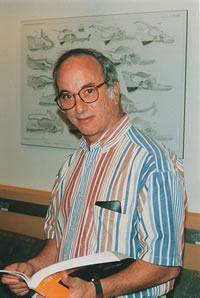
Researchers at the Bloedel Center have identified genes that may be involved in presbycusis. This work corresponds with analyses of data from the famous Framingham Heart Study. The study of more than 5,000 men and women between the ages of 30 and 62 from the town of Framingham, Mass., began in 1948 to track common factors of cardiovascular disease. Every two years the subjects, and now their children, have had extensive physical examinations and lifestyle interviews. The study gives medical researchers an invaluable pool of genetic data to analyze for a variety of illnesses.
In the Framingham study, according to Gates, children of parents with presbycusis suffer similar patterns of hearing loss at the same time in life. Perhaps in the next 10 to 20 years, researchers may be able to prescribe drugs that specifically target and manipulate the genes that control cell division and death in the inner ear.
While some look at prevention of hearing loss through gene therapy, others investigate restoring a weakened sense of hearing. In Rubel's lab, researchers found that birds regenerate damaged hair cells seemingly spontaneously. Jennifer Stone, a research assistant professor in otolaryngology, wants to track the step-by-step biochemical process that enables chickens to regenerate hair cells. Understanding each step in birds would eventually allow researchers to identify what steps are missing in mammals.

Stone works mainly with chickens. Besides being less complicated in general, the hearing apparatus in birds is more easily accessible than that of mammals. The spiral-shaped human cochlea is encased in very dense bone. Birds have a relatively straight cochlea that can be preserved outside of the body.
"Ultimately the goal is to compare what we find in the chicken to what is known about mammals," Stone explains. She wants to know why mammals do not have the natural ability to regenerate hair cells.
Scientists speculate that this ability was lost in something like an evolutionary compromise. Mammals have the ability to hear higher frequencies than chickens, but they no longer regenerate hair cells. Researchers theorize nature selected mammals that could hear better in their youth-rather than those that could regenerate hearing as they age.
"The amount of mass on a tissue affects how the tissue vibrates," says Elizabeth Oesterle, a research associate professor in Rubel's group. "A sensory system that is encoding high frequency sounds does not have the luxury of having extra cells."
Dogs and bats are other examples of animals with sensitive hearing that do not regenerate hair cells. Oesterle, who has been a pioneer in understanding hair cell regeneration in mammals, has been able to induce the first stages of hair cell regeneration to a limited extent in the inner ear of rodents. She's looking for molecules that can kick in the production of larger numbers of hair cells-but not too many. Mammalian organs have a very elaborate way of putting the brakes on cell division, whether it is cells in the heart or the retina. The overproduction of cells, after all, results in cancer. The molecules responsible for signaling cell division are similar across tissue types and even across species.
The same molecules expressed in cancer may one day be important in stimulating the regeneration of hair cells in the inner ear after damage. In order for the process to be clinically applicable in hearing loss research, scientists must be able to turn these molecules on and off.

UW Professor Ed Rubel. Photo courtesy Bloedel Hearing Research Center
In one experiment, published by Rubel's group in collaboration with investigators at the Fred Hutchinson Cancer Research Center, mice that lacked one of the genes controlling cell division were shown to produce extra inner- ear hair cells. The indiscriminate overproduction, the group reported, eventually caused a severe hearing loss.
Will hearing loss be "cured" in the next few years? Probably not. But work at the Bloedel Center is helping the process along. Rubel envisions a kind of Manhattan Project-with researchers from many different disciplines working at the UW on the problem of inner-ear hair cell regeneration in mammals.
"Any small bits of knowledge that we can gain about the biology and the physiology of hearing, and cellular biology of the inner ear or brain pathways may be critical down the line for clinical applications," says Rubel.
"When human beings first decided to ride a horse, rather than walk from one place to another, could we have predicted the current land speed record?" asks Rubel. "I doubt it. We're at that level. Just 15 years ago nobody believed that regeneration of the hair cells in the inner ear could possibly happen-let alone restore hearing. Now we know hair cell regeneration almost perfectly restores hearing in all of the other vertebrates that hear complex sounds. The challenge that lies ahead is to make that happen in us. "
--Pamela Wyngate is a science writer for the UW School of Medicine. She has also written for Rockefeller University and Oxford University Press in New York.
-
Go To: Page 1 | Page 2 | Page 3
- Sidebar: Celebrities Who Don't Hear the Applause
- Return to December 2001 Table of Contents